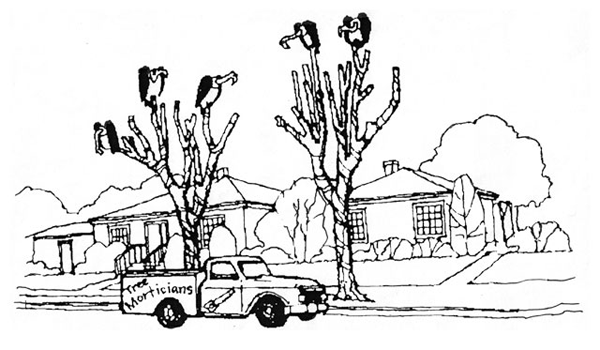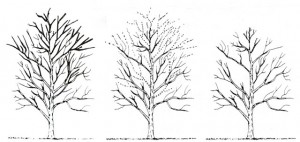
uring the bleak season of winter, when the bare silhouettes of towering trees preside over our seer and silent landscapes, the terrible crimes are revealed for all to see. Now in full view are the scars of the most harmful tree pruning practice there is—tree topping. Despite more than 25 years of efforts to alert the public by certified arborists, forestry agencies, academics, garden writers and tree activists, there are still untrained, oblivious tree care services performing this butchery on hapless trees.
“Topping” means bluntly cutting back tree branches, and even–most egregiously–amputating the top of the main trunk of a tree. The result is a sad, hatrack profile of maimed, stubbed branches and a tree stripped of its dignity, grace and character. Most commonly topping is done to reduce the size of a mature tree that has grown too big for its site. Enlightened professional arborists know methods of judiciously and sensitively cutting back branches, called crown reduction, that will not harm a tree. These methods are simple enough for untrained tree services and inexperienced homeowners who take the trouble to learn them.
Topping damage
The irony of topping or stubbing a tree is that it does not accomplish the goal of downsizing the tree. Instead, it stimulates it to rapidly produce replacement growth to reach its previous stature. This effort seriously and permanently compromises its health and appearance.
Every tree species is hardwired to grow in a certain shape, with a certain branching pattern, to a certain mature height. When its limbs and trunk are unceremoniously blunted back from their tips, a tree is forced into emergency mode and sacrifices everything to generate replacement tissue and life-sustaining foliage as quickly as possible. It generates lots of spindly branch sprouts to compensate for the traumatic loss. They then grow lanky and long to the original height of the tree’s limbs, making the canopy denser, yet weaker.
Tree topping causes suffering
- Shock. The community of plants and other living things depending on the shade of the tree’s foliage are now threatened by its loss, which exposes them and the tree’s bark to glaring sun.
- Starvation. A topped tree loses significant amounts of protective leaf canopy. It can’t absorb enough sunlight to make the energy that it needs to stay robust.
- Weakness. The wood that grows back in response to topping trauma is weak and more vulnerable to wind damage.
- Sickness. Stressed trees are vulnerable to pest infestations and diseases which exploit their diminished vigor. Typically, topped branches are fairly large in diameter, and have difficulty generating enough special healing tissue, to completely close the wounds, so insects and fungi can invade and promote decay.
- Mutilation. Once an asset to your landscape, a topped tree becomes an eyesore.
The hidden cost of topping
What you save by hiring an inexpensive, unskilled worker with a chainsaw who simply amputates ends of limbs and trunks of trees, you pay later. One cost is reduced property values. Real estate experts estimate that a large, lovely tree can add 10-20 percent to the value of a property. Then there is the cost of caring for a weakened tree in the future, the expense of removal and replacement when it sickens and dies prematurely, plus the cost of replacing other plantings that depended on the tree canopy. There may be the loss of heating or air conditioning savings due to the protection of large trees. Finally, there is the potential liability from weakened tree branches that fall on something or someone.
Avoid topping
Choose new trees for your landscape mindful of their potential mature size. That eliminates the need for severe pruning for size–ever. If trees are improperly sited already, consider moving young ones to a roomier spot. Hand dig and transplant them, much as you would a shrub. Have larger ones moved by an arborist with the assistance of a mechanical tree spade. When neither option is feasible, begin a regular pruning schedule to gently guide the tree’s growth. Every three years lightly clip back the tips of lengthening branches to a jointure with a shorter branch or twig to produce a shapely, sturdy mature tree. A good pruning job on a tree is like a good haircut. Afterward, it does not look as if it has just been cut.
By Liz Ball, Marple Tree Commission


